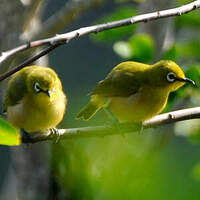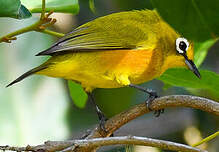Mayotte White-eye
Zosterops mayottensis - Zostérops de Mayotte
Identification
The Mayotte White-eye is one of the endemic species of the island. Like all the birds of the zosteropidae family, the Mayotte White-eye is the size of a warbler. Known locally as the bird with glasses due to its large white orbital circle. Not to be confused with its cousin, the Zosterops olivaceus, found on Réunion.
The Mayotte White-Eye is green-yellow on the back, while its head, throat, and chest are bright yellow. A well-visible black line connects the two orbital circles at the base of the beak. The flanks are beige-orange in color. The legs are greyish-blue and its beak black. There is no sexual dimorphism.
It is called Shilaputu in the Shimaorais language, or Shiberi in Shibushi.
Subspecific information monotypic species
Foreign names
- Zostérops de Mayotte,
- Anteojitos de la Mayotte,
- olho-branco-de-maiote,
- Dotterbrust-Brillenvogel,
- mayotte pápaszemesmadár,
- Mayottebrilvogel,
- Occhialino di Mayotte,
- mayotteglasögonfågel,
- Ildflankebrillefugl,
- okánik hnedoboký,
- kruhoočko hnědoboké,
- Mayottebrillefugl,
- mayottenrilli,
- zostèrops de l'illa Mayotte,
- szlarnik żółtopierśny,
- Каштановобокая белоглазка,
- マヨットメジロ,
- 栗胁绣眼鸟,
- mayotteglasögonfågel,
- 安朱恩繡眼,
Voice song and call
Habitat
The Mayotte White-eye prefers the arid forests of the island and open areas where it seeks out low shrubs.
It is almost absent from humid forests.
Behaviour character trait
Like all White-eyes, the Mayotte White-eye is a gregarious bird that moves in groups and does not hesitate to mix with other species when searching for food. It maintains an auditory and visual contact with all its congeners in the group thanks to small, sharp cries. A lively and acrobatic bird, it does not stay in one place for long and remains somewhat shy.
Dietfeeding habits
Reproduction nesting
Geographic range
Threats - protection
IUCN conservation status
concern
in the Wild
threatened
evaluated
The Mayotte White-eye is common on the island where it is not threatened. Today there is a slight decline due to loss of habitat, but not enough to consider it vulnerable. Less than 10% decrease in the mature population over 10 years.
Sources of information
- IOC World Bird List (v15.1), Gill, F and D Donsker (Eds). 2025-12-07.
- Oiseaux des iles de l'océan Indien, Langrand Olivier, ian Sinclair
- Les Oiseaux de Mayotte, Clément Michel, Grissac Philippe, Rolland Robin
- xeno-canto, Sharing bird sounds from around the world,
- BirdLife International, BirdLife International
- Birds of the World, The Cornell Lab of Ornithology
- GEPOMAY,
Other sources of interest
 Specification sheet created on
26/07/2023 by Nathalie Santa Maria
Specification sheet created on
26/07/2023 by Nathalie Santa MariaTranslation by AI Oiseaux.net
© 1996-2026 Oiseaux.net
- Accipitriformes
- Aegotheliformes
- Anseriformes
- Apodiformes
- Apterygiformes
- Bucerotiformes
- Caprimulgiformes
- Cariamiformes
- Casuariiformes
- Charadriiformes
- Ciconiiformes
- Coliiformes
- Columbiformes
- Coraciiformes
- Cuculiformes
- Eurypygiformes
- Falconiformes
- Galliformes
- Gaviiformes
- Gruiformes
- Leptosomiformes
- Mesitornithiformes
- Musophagiformes
- Nyctibiiformes
- Opisthocomiformes
- Otidiformes
- Passeriformes
- Pelecaniformes
- Phaethontiformes
- Phoenicopteriformes
- Piciformes
- Podargiformes
- Podicipediformes
- Procellariiformes
- Psittaciformes
- Pterocliformes
- Rheiformes
- Sphenisciformes
- Steatornithiformes
- Strigiformes
- Struthioniformes
- Suliformes
- Tinamiformes
- Trogoniformes


























